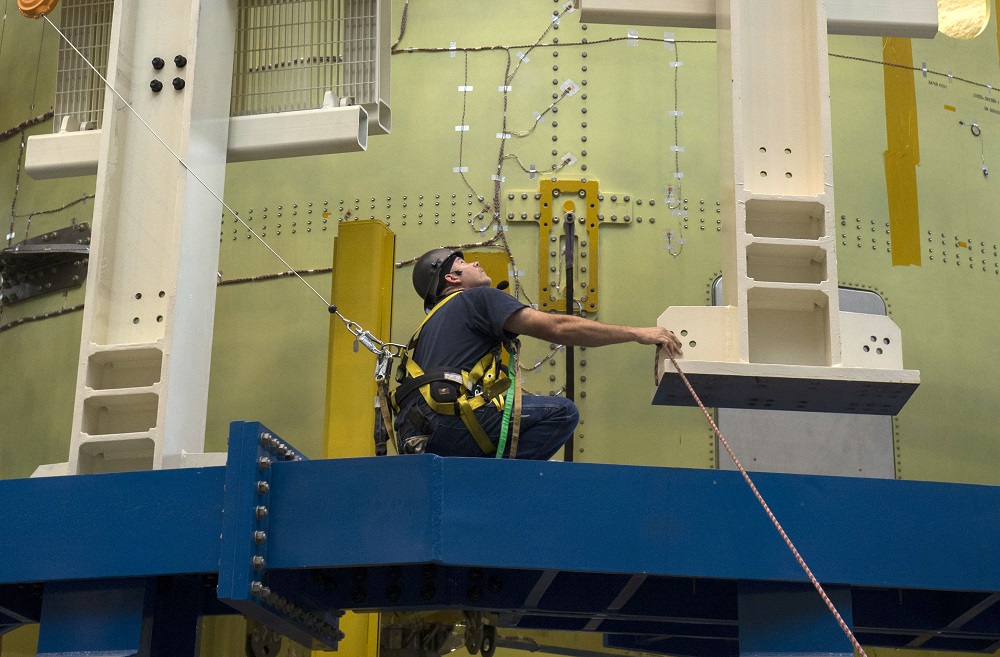
Roger Myrick, engine section mechanical lead technician, and other NASA engineers installed the SLS core stage engine section structural test article into Marshall’s newly constructed, 50-foot structural test stand. The completely self-reacting test stand occupies significantly less space than traditional rocket test stands. Image credit: NASA/MSFC/Emmett Given
After numerous tests using millions of pounds of force, engineers have successfully completed structural qualification testing on the engine section for NASA’s new deep-space rocket, the Space Launch System.
A true powerhouse, with four RS-25 engines and side attachment points for two solid rocket boosters, the engine section is located at the bottom of the rocket’s massive core stage. The 212-foot-tall core stage will be the backbone of all SLS configurations, making the tests critically important for upcoming missions sending crews to the Moon, Mars and beyond.
During launch, the engines and boosters will produce more than 8 million pounds of thrust, requiring the engine section to be incredibly strong.
“These tests mark significant progress to the pad for the first flight of SLS,” said Mark White, lead test engineer for the engine section at NASA’s Marshall Space Flight Center in Huntsville, Alabama. “The tests performed by NASA with core stage prime contractor Boeing prove the hardware is strong enough to withstand the stresses and loads of launch and ascent.”
The engine section structural test article was built at NASA’s Michoud Assembly Facility in New Orleans, and shipped to Marshall for testing. At Marshall, the hardware was installed into a unique 50-foot test stand where electronically controlled hydraulic cylinders pushed, pulled and bent the test article with millions of pounds of force.
“SLS will be the most powerful rocket in the world and to simulate the incredible loads it will produce, NASA and Boeing had to be innovative when designing the stand,” said White. “A traditional test stand, reacting onto the concrete, would have filled the entire test bay, leaving no room to maneuver and install the hardware.”
Traditional structural test stands are bolted to deep concrete foundations to absorb the force from the test back the ground. The Marshall test stand — which looks much like a bird cage built around the test article — is completely self-reacting, meaning the test stand itself is designed to be both strong enough and flexible enough to withstand the energy of the test. It sits on only four concrete pads, each roughly the size of a pizza box, allowing the stand to be more compact and flexible.
Inside the 1.7 million-pound test stand, the engine section test article hangs with a cryogenic supply system simulating the frigid temperatures created by the rocket’s liquid hydrogen tank. Using more than 16,000 fasteners, the test article is connected to the stand and the more than 50 actuators used to simulate the expected flight loads.
During tests, the actuators simulated more than 3 million pounds of upward RS-25 engine thrust loads and up to 750,000 pounds of loads on each side for the outward forces created by the solid rocket boosters. A series of tests also validated brackets designed to hold feedlines from the liquid oxygen tank.
Located near the top of the rocket’s core stage, the liquid oxygen tank will supply the oxidizer needed to power the four RS-25 engines. The liquid oxygen will travel more than 150 feet to the engines down the outside of the core stage, past the intertank and liquid hydrogen tank, via a large feedline known as the “downcomer.” The tests verified that the engine section feedline brackets would perform as expected when the heavy liquid makes the turn toward the engines in flight.
Engineers recorded and analyzed over 3,000 channels of data for each test case to verify the capabilities of the engine section and downcomer. Teams compared the data to design and analysis models to validate the accuracy of the predicted loads.
“The core stage structural qualification test campaign is NASA’s largest such effort since the Space Shuttle Program,” said Heather Haney, SLS core stage dry structures test lead at Marshall. “Next, we’ll test the intertank and then the rocket’s two colossal fuel tanks. It’s an exciting time for the future of deep-space exploration, and these tests move SLS closer to its first launch.”
SLS, which is managed at Marshall, will enable a new era of exploration beyond Earth’s orbit, launching astronauts in NASA’s Orion spacecraft on deep-space exploration missions to the Moon and eventually to Mars. On the first flight of SLS, Exploration Mission-1, the rocket will send an uncrewed Orion thousands of miles beyond the Moon before the spacecraft returns to Earth.
Major welding on all five parts of the core stage, including the engine section, for the first flight has been completed and the components are being outfitted for flight. The four RS-25 engines and engine controllers for the first mission have been certified and are ready to be joined to the engine section.
Filed Under: Aerospace + defense, Flanges • supports • mounts • brackets




